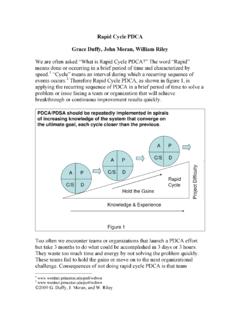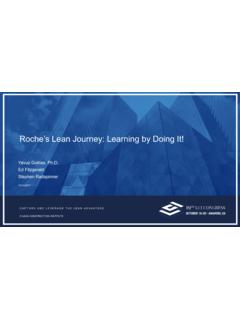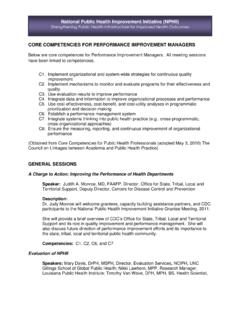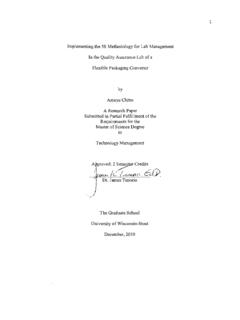Transcription of OSH Management System - International Labour Organization
1 OSH. Management System : A tool for continual improvement WORLD DAY FOR. SAFETY AND HEALTH. AT WORK. 28 April 2011 - Supported by the International Social Security Association WORLD DAY FOR SAFETY AND HEALTH AT WORK. 28 APRIL 2011. OSH Management System : A TOOL FOR CONTINUAL IMPROVEMENT. International Labour Organization 1 4/4/2011 1:31:27 PM. Copyright International Labour Organization 2011. First published 2011. ISBN 978-92-2-124739-5 (print). ISBN 978-92-2-124740-1 (web pdf). Also available in French: Syst me de gestion de la SST: un outil pour une am lioration continue. ISBN 978-92-2- 224739-4 (print) ISBN 978-92-2-224740-0 (web pdf), Turin, 2011, and Spanish: Sistema de gesti n de la SST: una herramienta para la mejora continua. ISBN 978-92-2-324739-3 (print).ISBN 978-92-2-324740-9. (web pdf), Turin, 2011.
2 Photographs International Labour Organization Design and production: International Training Centre of the ILO, Turin Printed in Italy 2 4/4/2011 1:31:27 PM. Table of Contents 1. Risk assessment and 1. What is an Occupational Safety and Health Management System (OSHMS)?.. 3. The path to 4. The ILO and 5. OSHMS for national 7. OSHMS and organizations (enterprises).. 8. 9. Workers' 10. Small scale 11. OSHMS and high risk sectors .. 12. Chemicals and 13. Major Hazards 14. Nanotechnologies .. 15. Are Management Systems good for OSH?.. 15. Strengths of 16. Limitations of 17. ILO's Technical cooperation on safety and health Management 19. Final 20. 21. Annex 1 - Essential elements of an occupational safety and health Management 22. 3 4/4/2011 1:31:27 PM. Introduction Occupational safety and health (OSH) is a discipline dealing with the prevention of work- related injuries and diseases as well as the protection and promotion of the health of workers.
3 It aims at the improvement of working conditions and environment. Occupational health entails the promotion and maintenance of the highest degree of physical and mental health and social well-being of workers in all occupations. In this context, the anticipation, recognition, evaluation and control of hazards arising in or from the workplace that could impair the health and well being of workers are the fundamental principles of the process governing occupational risk assessment and Management . The possible impact on the surrounding communities and the general environment should also be taken into account. The basic learning process about hazard and risk reduction is at the root of the more sophisticated principles governing today's OSH. In present times, the need to master a galloping industrialization and its demand for highly and inherently dangerous energy sources, such as the use of nuclear energy, transport systems and increasingly complex technologies has led to the development of much more sophisticated risk assessment and Management methods.
4 For all areas of human activity, a balance has to be made between benefits and costs of risk taking. In the case of OSH, this complex balance is influenced by many factors such as rapid scientific and technological progress, a very diverse and continuously changing world of work, and economics. The fact that the application of the OSH principles implies the mobilization of all social and scientific disciplines is a clear measure of the complexity of this field. Risk assessment and Management The concepts of hazard and risk and their relationship can easily lead to confusion. A hazard is the intrinsic property or potential of a product, process or situation to cause harm, adverse health effects on someone or damage to something. It can come from a chemical (intrinsic properties), working on a ladder (situation), electricity, a compressed gas cylinder (potential energy), a fire source or more simply a slippery floor.
5 Risk is the likelihood or probability that a person will be harmed or experience adverse health effects if exposed to a hazard or that property will be damaged or lost. The relationship between hazard and risk is exposure, whether immediate or long term, and is illustrated by a simple equation: =. As described before, the essential purpose of OSH is the Management of occupational risks. In order to do that, hazard and risk assessments have to be carried out to identify what could cause harm to workers as well as property so that appropriate preventive and protective 1. 1 4/4/2011 1:31:43 PM. measures can be developed and implemented. The five step risk assessment method shown below was developed by the Health and Safety Executive in the United Kingdom as a simple approach to manage risks, particularly in small scale enterprises (SMEs) and has been endorsed globally: Table 1.
6 STEP 1 Identify the hazards STEP 2 Decide who might be harmed and how STEP 3 Evaluate the risks and decide on precautions STEP 4 Record your findings and implement them STEP 5 Review your assessment and update if necessary A risk assessment procedure can be easily tailored to the size and activity of the enterprise, as well as to the available resources and skills. A major hazard installation, such as a petrochemical plant will require highly complex risk assessment evaluations and mobilize a high level of resources and skills. Many countries develop their own risk assessment guidelines which are often used for regulatory purposes or to develop internationally agreed standards. Two risk assessment processes which are essential for the Management of occupational risks are the determination of occupational exposure limits (OEL) and the establishment of lists of occupational diseases.
7 Most of the industrialized countries establish and maintain OEL. lists. These limits cover chemical, physical (heat, noise, ionizing and non ionizing radiation, cold), and biological hazards. One list that is outstanding in terms of coverage and strong scientific peer-review process, and therefore used as a reference by other countries, is the List of Threshold Limit Values (TLVs) of the American Conference of Governmental Industrial Hygienists (ACGIH). The incorporation of occupational diseases in national lists is also based on hazard and risk assessment procedures for the identification and recognition of occupational diseases for compensation purposes. These range from illnesses such as respiratory and skin diseases, musculoskeletal disorders and occupational cancer to mental and behavioural disorders.
8 The ILO List of occupational diseases (revised in 2010) assists countries in the design of their own national lists, in prevention, recording, notification and, when applicable, compensation of diseases caused by workplace exposure. 2. 2 4/4/2011 1:31:57 PM. What is an Occupational Safety and Health Management System (OSHMS)? The notion of Management systems is used often in the decision making processes in business and unknowingly also in daily life, whether it is in the purchase of equipment, the extension of business or more simply the selection of new furniture. The application of Occupational Safety and Health Management Systems (OSHMS) is based on relevant OSH criteria, standards and performance. It aims at providing a method to assess and improve performance in the prevention of workplace incidents and accidents via the effective Management of hazards and risks in the workplace.
9 It is a logical, stepwise method to decide what needs to be done, how best to do it, monitor progress toward the established goals, evaluate how well it is done and identify areas for improvement. It is and must be capable of being adapted to changes in the business of the organisation and to legislative requirements. Figure 1: The Deming Cycle1. This concept of a process is based on the principle of the Plan-Do-Check-Act Deming Cycle (PDCA), designed in the 1950s to monitor business performance on a continual basis. When applied to OSH, Plan involves the setting of an OSH policy, planning including the allocation of resources, provision of skills and organisation of the System , hazard identification and risk assessment. The Do step refers to actual implementation and operation of the OSH programme.
10 The Check step is devoted to measuring both the active and reactive performance of the programme. Finally the Act step closes the cycle with a review of the System in the context of continual improvement and the priming of the System for the next cycle. An OSHMS is a logical toolbox that is flexible and can be tailored to the size and activity of the organisation and be focused on general or specific hazards and risks associated with such activity. Its complexity can range from the simple needs of a small enterprise running a single 1 Diagram by Karn G. Bulsuk: ( #axzz1 GBg5Y7Fn). 3. 3 4/4/2011 1:31:57 PM. product process where hazards and risks are easy to identify, to multiple hazard industries such as mining, nuclear power, chemical manufacturing, or construction. The OSHMS approach ensures that: the implementation of preventive and protective measures is carried out in an efficient and coherent manner.















